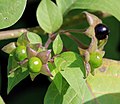Top Qs
Timeline
Chat
Perspective
Hyoscyameae
Tribe of flowering plants From Wikipedia, the free encyclopedia
Remove ads
Hyoscyameae is an Old World tribe of the subfamily Solanoideae of the flowering plant family Solanaceae. It comprises seven genera: Anisodus, Atropa, Atropanthe, Hyoscyamus, Physochlaina, Przewalskia and Scopolia.[1] The genera Atropanthe and Przewalskia are monotypic, the first being endemic to China and the second to Tibet.
All seven genera of the tribe are poisonous and have a long tradition of use as medicinal plants, being rich in tropane alkaloids with anticholinergic properties.[2] Furthermore, the genera Atropa, Hyoscyamus, Scopolia and Physochlaina have furnished entheogens - the first three in the historical context of European witchcraft and, more specifically, of the flying ointments employed in such practices,[3] while the similar chemistry of the remaining genera points to the potential for entheogenic use. Six of the genera have dry, pyxidial fruits i.e. capsules dehiscing by an operculum and thus resembling a pot with a lid. The fruit of the remaining genus Atropa is a glossy, juicy berry, making Atropa species especially dangerous poisonous plants, since - unlike other Hyoscyameae - their attractive fruits may easily be mistaken for edible berries, particularly by children - as has frequently occurred in the case of Atropa belladonna, the infamous Deadly Nightshade.[4]
An eighth genus referable to Hyoscyameae remained unresolved until 2020: the poorly-known, monotypic genus Pauia contained the single species Pauia belladonna Deb and Dutta native to Assam and Arunachal Pradesh. The late Professor Armando Theodoro Hunziker, one of the foremost authorities on the Solanaceae, was of the opinion that Pauia should be subsumed in Atropa. The plant resembles the Indian Atropa acuminata, but differs from it most markedly in bearing a berry that, unlike those of other Atropa species, is not globose but oblong in shape, somewhat resembling that edible Solanaceous fruit the Goji.[5] In 2020, the species was reclassified into genus Atropa as Atropa indobelladonna.[6]
Remove ads
Gallery
- Pyxidial fruits of black henbane Hyoscyamus niger
- Anatomy of Hyoscyamus niger showing dissected pyxidium etc.
- Golden henbane Hyoscyamus aureus single flower
- Hyoscyamus aureus in flower and fruit
- Egyptian Henbane Hyoscyamus muticus single flower interior
- Hyoscyamus muticus plant in flower and fruit
- Hyoscyamus reticulatus flowers in close-up
- Hyoscyamus reticulatus flowering plant growth habit
- Flower of Atropa belladonna in close-up, showing curled stamens
- Atropa belladonna in fruit : ripe and unripe berries
- Atropa belladonna ripe berry in close-up
- Anatomy of Atropa belladonna flower and berry
- Botanical illustration of Atropa baetica, Andalusian belladonna
- Scopolia carniolica: two flowers in close-up, showing unripe anthers - yet to dehisce.
- Scopolia carniolica in flower
- Anatomy of Scopolia carniolica, showing pyxidium etc.
- Scopolia carniolica: fruiting calyx dissected to reveal dehiscence of ripe pyxidium.
- Rhizome of Scopolia carniolica
- Scopolia japonica (Japanese: 走りどころ Hashiri-dokoro) in flower
- Single flower of Scopolia japonica showing dehiscence of ripe anthers
- Anisodus tanguticus, showing interior of flower
- Flower and foliage of Anisodus luridus
- Flowers of Physochlaina orientalis
- Interior of pyxidium of Physochlaina orientalis
- Ripe fruits of Physochlaina orientalis, showing nodding growth habit
- Physochlaina physaloides foliage and inflorescence (Curtis's botanical magazine)
- Dissected fruit of Physochlaina physaloides with detached operculum
- Physochlaina praealta foliage and inflorescence
Remove ads
References
Wikiwand - on
Seamless Wikipedia browsing. On steroids.
Remove ads





























